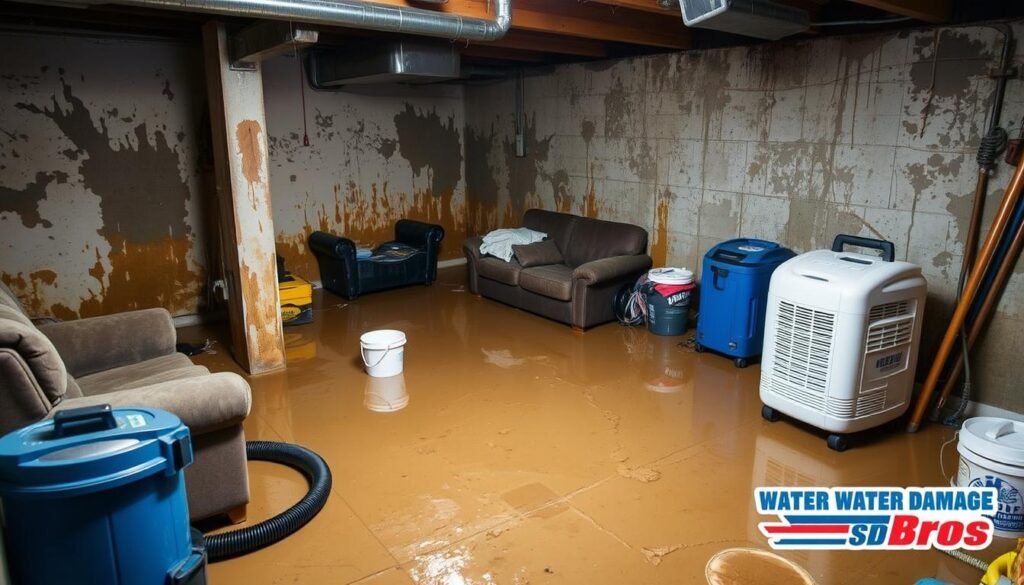Did you know mold can start growing in just 24–48 hours after a flood? This shows how fast we need to act in water-damaged areas. Flooding, from burst pipes to heavy rain, creates a perfect spot for mold to grow. This is a big risk for your property and health.
Experts say waiting too long to fix flood damage can lead to more mold. Moisture and organic materials in damaged areas are like a welcome mat for mold spores. These spores are everywhere and can spread easily through the air.
It’s important to understand how flood damage and mold growth are connected. This helps us control moisture and keep the air inside clean. Health experts say keeping humidity levels between 30-50% can stop mold. But, floods can quickly raise these levels, making it necessary to call in mold experts.
Key Takeaways
- Mold can start growing within 24-48 hours after flooding
- Prompt water damage restoration is crucial to prevent mold growth
- Flooding creates ideal conditions for mold proliferation
- Mold growth can lead to serious health hazards and respiratory issues
- Maintaining indoor humidity levels between 30-50% helps prevent mold
- Professional mold remediation may be necessary after significant water damage
Understanding Flood Damage
Flood damage can cause a lot of problems for your home. It can lead to immediate and long-term issues. When water gets into your home, it’s important to act quickly. This helps prevent mold and other problems.
What Happens to Your Home During a Flood?
Water can get into every part of your home during a flood. It can damage walls, floors, and your belongings. Wet carpets can grow mold, and electrical systems might short-circuit, which is dangerous.

Key Signs of Flood Damage
Here are some signs of flood damage:
- Water stains on walls or ceilings
- Warped or bubbling flooring
- Musty odors
- Visible mold growth
Immediate Steps to Take After Flooding
Quick action is crucial for cleaning up a flooded basement. Here’s what to do:
- Ensure safety by turning off electricity and gas
- Remove standing water using pumps or buckets
- Start the drying process with fans and dehumidifiers
- Contact water damage repair pros for professional assessment
Moisture control is key to stopping mold growth. Mold can start growing in 24 hours after water damage. Use dehumidifiers to keep humidity low during the restoration.
“Immediate action is crucial to prevent mold growth after a flood.”
Different materials need different treatments. For example, you might need to cut away wet wall materials or throw away wet insulation. It’s best to talk to water damage repair pros. They can help with the right handling and ensure moisture control in your home.
The Risk of Mold Growth After a Flood
Floods create perfect conditions for mold growth in your home. It’s important to understand this risk to protect your property and health. Let’s look at why flooded areas are mold breeding grounds and what you can do.
Why Mold Thrives in Flooded Areas
Mold loves moisture and organic materials, both found after a flood. Wood, drywall, and carpet are like food for mold spores. Poor ventilation traps humidity, making it a perfect place for mold to grow. A mold inspection is key to assess damage and plan for fixing it.

Common Types of Mold to Watch For
Several mold types can invade your home after a flood. Here are the most common:
- Black mold (Stachybotrys chartarum)
- Aspergillus
- Penicillium
- Alternaria
Each type can affect indoor air quality differently. This makes professional assessment very important.
How Quickly Can Mold Develop?
Mold growth is surprisingly fast after flooding. The Environmental Protection Agency says mold can start growing within 24 to 48 hours in ideal conditions. Visible colonies often appear in 18 to 21 days if not treated.
| Time Frame | Mold Development Stage |
|---|---|
| 24-48 hours | Mold spores begin to grow |
| 3-5 days | New mold colonies form |
| 18-21 days | Visible mold growth appears |
Quick action is crucial. Proper dehumidification and drying within this window can stop mold growth and keep your home safe.
Preventing and Addressing Mold Growth
Mold prevention is key after flood damage. Experts say mold can grow in 24 to 48 hours after water exposure. This shows why quick action is vital to avoid long-term problems.
Effective Mold Prevention Strategies
To fight mold, keep humidity under 60%. Use dehumidifiers and open windows more. Remove wet items fast and clean surfaces with products that stop mold.
The CDC suggests a bleach solution of one cup per gallon of water for mold cleaning. Check plumbing and roofs often to find water leaks early.
Professional Help from Water Damage Pros – San Bernardino
For big floods or mold, get professional help. Water Damage Pros – San Bernardino has the skills and tools for mold removal. They make sure your home is safe again.
Remember, stopping mold and fixing it right is crucial for your health and home after a flood.


